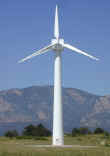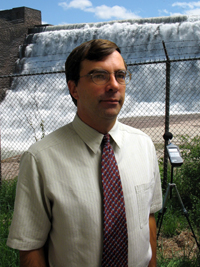Tech Environmental e-Newsletter
OF SMALL-SCALE WIND POWER However, recent developments in wind turbine design have made small-scale wind power generation much more practical. High-efficiency blade designs, featuring stronger, lighter, larger blades, have led to greatly improved power production, reduced costs, and low noise levels. The new turbines are now practical and competitive for wide-scale power generation usage. In particular, small-scale wind projects are now being advanced by private developers who wish to power their facilities with wind, as well as by communities who wish to construct municipal wind power generating stations to reduce citizens' electrical costs. The first type of project usually has power levels below 2 MW, while the second usually has power levels up to 10 MW.
The demand for these installations is evident across the Northeast: a columnist for the Providence Journal recently called for small-scale wind in Rhode Island, while a selectman in Hampton, New Hampshire is pushing for that municipality to utilize wind power to its benefit. The Portland Press Herald reported recently that several Maine towns are following the lead of Saco, ME, which has installed one wind turbine and is considering adding another. An Amherst, NH man made headlines with his attempt to install wind turbines on his property to power his house, while a recent article reports that hundreds of small wind turbines are being installed at homes in upstate New York. A lengthy Boston Globe article described the movement toward small-scale wind power as reaching "critical mass," describing efforts to install wind turbines at such diverse facilities as a community college, a high school, a union hall and a ski resort. At present, a large number of other small-scale wind projects are being studied in the Northeast. Addressing concerns about appearance, noise, shadow flicker, bird migration and air traffic obstruction has proven to be a significant challenge for potential project developers, both private and community-based. A recent Salem [MA] News editorial noted delays in a small-scale wind project on Cape Ann due to legislative wrangling over the issue of wind turbines. However, when relevant legislation is finalized and put in place across the Northeast, small-scale wind projects will be able to move forward with more certainty in the region. With luck and regulatory/legislative cooperation, a sizeable fraction of these sites will prove to be acceptable for wind power generation, and will soon begin to provide clean, renewable power. For more information, contact Peter Guldberg at PGuldberg@techenv.com or at ext. 106.
ONGOING SMALL-SCALE WIND PROJECTS Many of you have no doubt heard about some of the high-profile wind farms for which Tech Environmental has provided noise and vibration services, including the Cape Wind Project off the coast of Massachusetts. However, TE is presently assisting a number of developers and municipalities with small-scale wind projects as well. Some of these projects are in coordination with the Massachusetts Technology Collaborative (MTC), the state's economic development agency for renewable energy and the information economy. TE provides noise and vibration analysis to determine the impacts from proposed wind turbines, and demonstrates those impacts using computer models. Ongoing TE small-scale wind projects in Massachusetts include four turbines for the town of Eastham, a pair of turbines for the Town of Fairhaven, a single turbine proposed on industrial land by a private developer in Gloucester, and a single turbine proposed by a private developer at a private high school in Worcester. We will continue to augment our work on high-profile, large-scale efforts with small-scale projects like these, in the hopes that the Northeast can continue to develop innovative energy sources to match its ever-growing demand for power.
SUBSCRIBE TO THIS NEWSLETTER If you have been forwarded this email and wish to receive it regularly, |
TECH ENVIRONMENTAL WELCOMES Tech Environmental is pleased to welcome Dr. Quin has performed noise measurement and acoustic modeling impact assessments for transit, power plant, wind turbine, highway, airport, harbor, construction and stationary source facilities in the Northeast, Mid-Atlantic and Midwest regions. He has worked on a variety of complex projects, including several on-going wind turbine projects in New England; the construction of new tunnels and platforms at Grand Central and Penn Stations in New York City; Boston mass transit projects like the Urban Ring and Blue Line Extension; and a massive General Electric remediation project to remove PCBs from the Hudson River. Dr. Quin has performed noise measurement and acoustic modeling impact assessments for projects including the high-profile commercial South Station Development and Bullfinch Triangle Redevelopment in Boston; impacts from a municipal wastewater facility, the MWRA Union Park facility in Boston; a harbor configured for offloading liquefied natural gas, the Weaver’s Cove LNG Facility in Fall River, MA; and blast monitoring projects at mines in Reading, PA and Hazleton, PA. Dr. Quin also has extensive experience on transportation projects, performing noise and vibration analysis, computer modeling, and design recommendations on projects like the Dulles Corridor Rapid Transit line in Washington D.C. Dr. Quin is not only highly conversant with a number of contemporary software programs, including Cadna/A, SoundPlan, TNM, WindPro, and INM, but he understands the programming logic used as a basis for each software package. As a result, he has developed customized software on occasions when a project’s needs require it. Dr. Quin wrote transit noise modeling software to model noise from commuter trains, buses and transit lines using algorithms developed by the FTA; this code was used on several transit noise projects, such as the New Jersey Transit ARC and the MBTA North Shore and Urban Ring Projects. Dr. Quin obtained a B.S. in Physics and a M.S. in Geophysics from Stanford University, and a PhD. in Geophysics from Columbia University. You can contact Dr. Quin at HQuin@techenv.com or at 781-890-2220, ext. 102.
CONTACT US Waltham, Massachusetts 02451 ph. 781-890-2220 fax 781-890-9451
We are located at Reservoir Place on Trapelo Road off Exit 28, Rt. 128/I-95 in Waltham, Massachusetts.
|
| TECH ENVIRONMENTAL, INC. specializes in finding real solutions to air quality, odor control, noise and vibration, fugitive dust, and health & safety challenges. Our focused knowledge in air-quality-related fields is enhanced by a comprehensive understanding of environmental regulations and technologies. Visit our website at www.techenv.com or contact us by phone at (781) 890-2220. |




